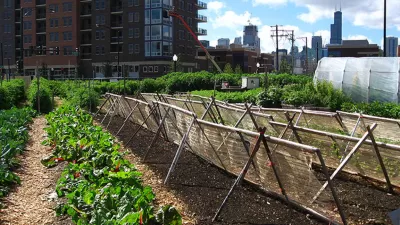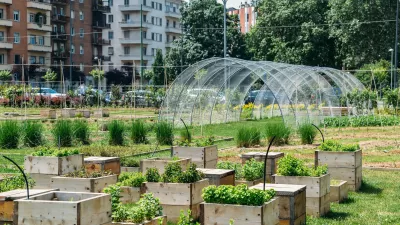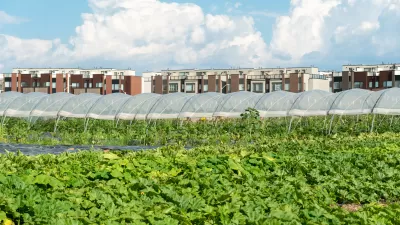Throwing cold water on the latest "techno-optimism" for indoor, urban agriculture.

Joe Cortright writes of his skepticism about urban farming—despite the popularity of "techno-optimistic stories about how a new era of hyper-local food grown in your neighborhood or very nearby." The latest example of which, and the inspiration for Cortright's response, is an article by Adele Peters for Fast Company: "Has This Silicon Valley Startup Finally Nailed the Indoor Farming Model?"
"While the story is replete with VC-pitch based talking points about the efficiency of some aspects of the indoor farming model–purportedly 1 percent as much water use as field crops, 30 miles to the consumer, not 3,000, plus [Plenty] uses LED lights are 64 times more cost-effective than those available a few years ago–one fact is conspicuously missing from the narrative," writes Cortright. That is: "How much will consumers be asked to pay for indoor-grown kale and basil?"
Cortright's concern is with the "dubious" economics of urban agriculture. According to his calculations, urban farming has to 100 times more efficient than conventional farming to cover the cost of land. Instead of a game changer of sustainability, Cortright predicts indoor farming will remain a niche technology for specialized, premium products.
FULL STORY: Dirt cheap.

Planetizen Federal Action Tracker
A weekly monitor of how Trump’s orders and actions are impacting planners and planning in America.

Congressman Proposes Bill to Rename DC Metro “Trump Train”
The Make Autorail Great Again Act would withhold federal funding to the system until the Washington Metropolitan Area Transit Authority (WMATA), rebrands as the Washington Metropolitan Authority for Greater Access (WMAGA).

DARTSpace Platform Streamlines Dallas TOD Application Process
The Dallas transit agency hopes a shorter permitting timeline will boost transit-oriented development around rail stations.

Supreme Court Ruling in Pipeline Case Guts Federal Environmental Law
The decision limits the scope of a federal law that mandates extensive environmental impact reviews of energy, infrastructure, and transportation projects.

Texas State Bills to Defund Dallas Transit Die
DART would have seen a 30% service cut, $230M annual losses had the bills survived.

Bikeshare for the Win: Team Pedals to London Cricket Match, Beats Rivals Stuck in Traffic
While their opponents sat in gridlock, England's national cricket team hopped Lime bikes, riding to a 3-0 victory.
Urban Design for Planners 1: Software Tools
This six-course series explores essential urban design concepts using open source software and equips planners with the tools they need to participate fully in the urban design process.
Planning for Universal Design
Learn the tools for implementing Universal Design in planning regulations.
Roanoke Valley-Alleghany Regional Commission
City of Mt Shasta
City of Camden Redevelopment Agency
City of Astoria
Transportation Research & Education Center (TREC) at Portland State University
US High Speed Rail Association
City of Camden Redevelopment Agency
Municipality of Princeton (NJ)





























